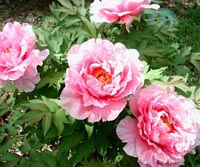Resource Library
Plant of the Week: Tree Peony
The University of Arkansas System Division of Agriculture does not promote, support or recommend plants featured in "Plant of the Week." Please consult your local Extension office for plants suitable for your region.
Plant of the Week
Tree Peony
Latin: Paeonia suffruticosa

As Americans, we tend to take an egocentric view of the world, often assuming that other places and cultures have little to offer. Because really old and rich civilizations such as China baffle and bewilder us, most Americans dismiss them as backwards, if they think of them at all. But, for gardeners we must embrace China for she has provided many of our most cherished garden flowers, including the stunningly beautiful tree peony.
Paeonia suffruticosa, the tree peony, is a deciduous woody shrub growing to 6 feet tall and wide. It has stout, sparsely branched stems and coarse, compound leaves with nine leaflets. The leaves are bright red when they emerge in early spring.
As the season advances, the flower buds begin to swell, reaching the size of a small apple before issuing forth in late April with a flower the size of a salad plate. Double forms are most common with the blossoms in delicate pastel shades of red, pink, white and yellow. The beauty of the flower is unsurpassed, making it easy to understand why the Chinese treasure tree peonies as Western culture does the rose.
Tree peonies have been mentioned in Chinese literature since the 4th century BC and have been an important garden plant since at least the Tang Dynasty (618-907). Chinese scholars look to this dynasty as a long, stable reign of rulers who promoted learning and the arts, including gardening.
This progressive age saw the elevation of women in Chinese culture, in large measure due to the efforts of Wu Zetian (625-705). Empress Wu was born into a noble family and, as a young girl became one of the ruler’s concubines. Through a series of deft maneuvers and palace intrigues, she had herself named Empress when her own son resigned the throne in 690, breaking with the long held Confucian teaching that only men could become rulers.
Empress Wu’s connection to the tree peony is probably pivotal in the development of the flower, for she is said to have banned it from her gardens and palaces because it failed to bloom as precociously as she felt it should. This banishment was the catalyst for breeders to develop the free-flowering forms that are found in gardens today. When European merchants and plant explorers introduced the plant to Europe, they simply purchased them from retail sources that had been growing and selling the plant for over 1,000 years.
Tree peonies can be grown in all parts of Arkansas but are less common in gardens than their herbaceous cousins. Their rarity in cultivation is because they’re difficult to propagate. The Chinese learned early on that they could be grafted onto the rootstock of an herbaceous peon, a straightforward but not necessarily easy grafting procedure. Many of the 350 named cultivars listed are old Chinese selections, simply given new names when they were introduced into Europe.
Tree peonies do best in a fertile, well drained garden soil. They will grow in full sun or light shade and are easy to grow if well sited. They should be watered during dry periods and fertilized with a topdressing of compost each spring. The flowers are susceptible to wind and weather during the time they are open, so afternoon shade and wind protection helps preserve the length of their all too short bloom display.
By: Gerald Klingaman, retired
Extension Horticulturist - Ornamentals
Extension News - April 1, 2005
The University of Arkansas System Division of Agriculture does not maintain lists of retail outlets where these plants can be purchased. Please check your local nursery or other retail outlets to ask about the availability of these plants for your growing area.